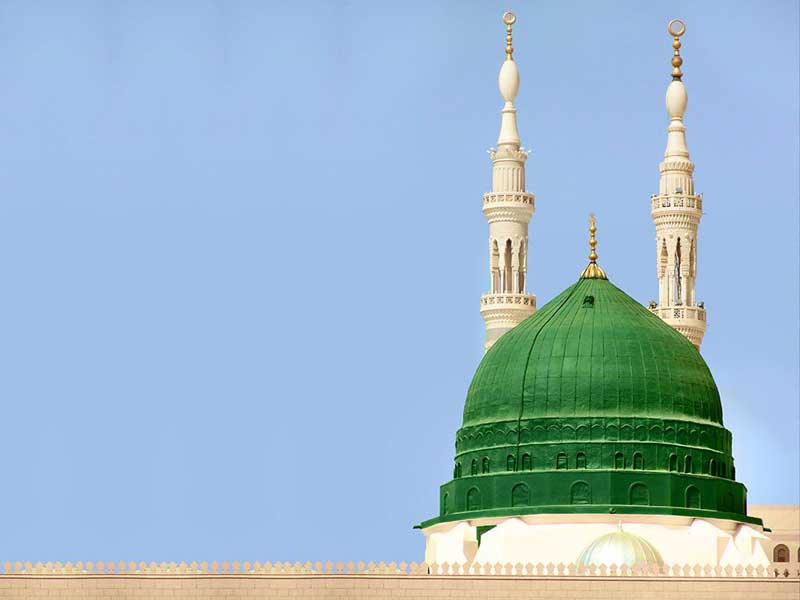
Located in the city of Medina in Saudi Arabia, Al-Masjid an-Nabawi was the second mosque built by Prophet Muhammad and the third mosque built in the history of Islam. Known as the Prophet’s Mosque in English, it is now one of the largest mosques in the world and the second holiest site in Islam, after the Al-Haram Mosque in Mecca. It is said that after his Hija or withdrawal from Mecca, along with his immediate followers in 622 AD, Muhammad’s camel called Qaswa, moved on with slackened reins and knelt on reaching the site of the present masjid. The Prophet alighted on the spot, declared it to be his home, and inquired about the owner of the land as he wished to acquire it and construct a mosque on the site. Although Sahl and Suhay, the two young orphans who owned the land, offered it to the Prophet as a gift, Muhammad insisted on paying a price because they were orphans. Finally, Abu Ayyub al-Ansari, a close companion of the Prophet, who accommodated him upon his arrival at Medinah in 622, paid the price and thus became the endower of Al-Masjid an-Nabawi.
It took seven months to complete the construction of the mosque, measuring 100`1 feet by 16`9 feet (30.5 m × 35.62 m), the roof of which was supported by palm trunks and was made of beaten clay and palm leaves. The 11`8 feet (3.60 m) tall mosque had three doors, the Gate of Mercy to the south, Gate of Gabriel to the west, and Gate of Women to the east. Originally, it was an open-air building and served as a community centre, a court of law, and a religious school. The Quran was taught from a raised platform or minbar, from where Muhammad used to deliver his Friday sermons. Later, the mosque was greatly expanded by the subsequent Islamic rulers, who decorated it, named the wall, doors, and the minarets after their names.

The two-storey tall modern Al-Masjid an-Nabawi stands on a rectangular plot and the Ottoman prayer hall, the oldest part of the mosque, lies toward the south. The flat, paved roof of the hall, topped with 27 sliding domes on square bases, is accessible by stairs and escalators. The paved area around the mosque, equipped with umbrella tents, is also used for prayer.
One of the most important sites of the mosque is the final resting place of the Prophet Muhammad and the first two Rashidun caliphs Abu Bakr and Umar, situated in the southwest corner. It is said that originally, Muhammad's grave was within the confines of Hujra, the house where he lived with his wife Aisha, and it was adjacent to the mosque. However, the mosque was extended during the reign of Caliph al-Walid I, to include the tomb. The original structure, with an unpainted wooden cupola built over the tomb, dates back to 1279 AD. Later, it was rebuilt twice in the late 15th century and once in 1817, and was painted in different colours each time. It was miraculously saved in 1805, when Saud bin Abdul-Aziz stormed and captures Medina, demolished nearly every tomb dome in the city, and Muhammad’s tomb was stripped of its golden decorations. The current dome was added by the Ottoman Sultan Muhammad II in 1818 and was painted green for the first time in 1837.

Consequently, it became famous as the Green Dome, one of the important reasons for the high sanctity of the mosque, as it marks the location of the tomb of the prophet. But the Rawdah Rasool, the grave of the prophet remains out of the view of the pilgrims as the area is cordoned off by a gold mesh and black curtains.


Al-Masjid an-Nabawi in Medina is equipped with two mihrabs, the semicircular niches in the wall that indicates the Qibla, the direction of the Kaaba in Mecca, the direction that Muslims should face at the time of prayer. While the original one, built by Muhammad is a commemorative mihrab, the other one, built later by the third Rashidun caliph Uthman, is larger and acts as the functional mihrab. In addition to the mihrabs, the mosque also has other niches, which act as indicators for praying and includes Mihrab al-Tahajjud, built by Muhammed for the Tahajjud, the late-night prayer.
The original minbar, the raised platform used by Muhammad for preaching his Friday sermons, was of a block of date-palm wood, which was later replaced by him and had dimensions of 20 inches by 49 inches. Later, a ladder with three steps was added to it in 629 AD. However, as a sign of respect to the Prophet, the first two caliphs did not use the third step. Uthman, the third caliph, added a fabric dome over the minbar, and the rest of the stairs were covered with ebony. The minbar was replaced twice, in 1395 and 1417, and the present minbar of marble was added in 2013.

Bab al-Salam, one of the ten minarets of Al-Masjid an-Nabawi, was added by Muhammad ibn Kalavun and was renovated by Mehmed IV in 1307 AD. After the completion of the massive renovation project of 1994, the mosque contains ten minarets of 341 feet (104 m) high, which are shaped with cylindrical top, octagonal bottom, and square in the middle.

The Rawdah ash-Sharifah, or the Noble Garden, the area between the minbar and the Rawdah Rasool, the burial chamber of Muhammad, is considered as one of the Riyad al-Jannah or the Gardens of Paradise. In contrast with the rest of the mosque, covered in a red carpet, Riyad al-Jannah is carpeted in soothing green.